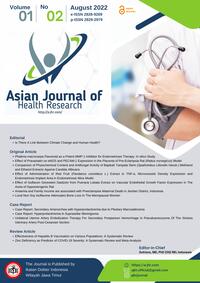Case Report: Hyperprolactinemia In Suprasellar Meningioma
Abstract
Introduction: Hyperprolactinemia is a condition in which abnormally elevated prolactin levels (normal prolactin levels are 10-28 g/L) is a common endocrine disorder. Establishing the diagnosis and etiology of hyperprolactinemia should include a thorough medical history and the use of drugs, physical examination, laboratory tests, analysis of the pituitary, and sella turcica features. Pituitary tumor imaging analysis using MRI remains the method of choice. The main goals of managing hyperprolactinemia are restoring and maintaining fertility function and preventing osteoporosis. The choice of treatment depends on the underlying etiology.
Case Presentation: A 33-year-old woman complained that her right side of vision could not function properly, and her left side of vision began to blur, which started four years ago with irregular menstrual disorders, and milk came out of her breasts. On breast examination, Tanner 5 was found with galactorrhea and pubic hair Tanner stage 3. On Laboratory examination found FSH (5.50 mIU/mL), LH (1.7 mIU/mL) and prolactin (1125 IU/mL). The MRI examination showed an extra-axial solid mass, broad-based on the planum sphenoidal to the dorsum sellae, suggesting a meningioma; with compression of the optic chiasm, middle cerebral artery, and bilateral anterior cerebral arteries, size 3.1 x 2.8 x 2.3 cm.
Conclusion: Hyperprolactinemia with meningiomas is a unique case. First-line therapy for prolactinomas is dopamine agonist administration and, in this case, is followed by surgery, which showed significant results.
Downloads
Published
Issue
Section
License
Copyright (c) 2022 Nirwan Nugraha, I Wayan Arsana Wiyasa, Donny Wisnu Wardhana, Wino Vrieda Vierlia , Edy Mustofa

This work is licensed under a Creative Commons Attribution 4.0 International License.








































